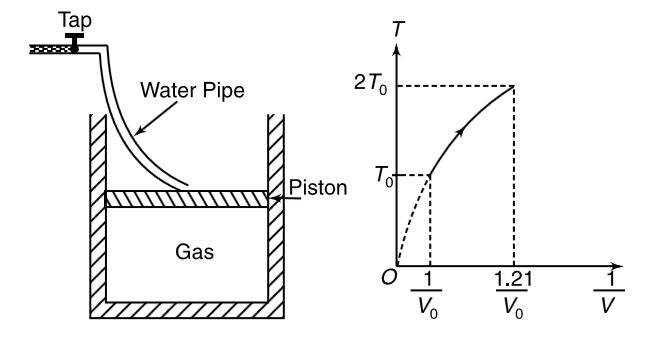A spherical container made of non conducting wall has a small orifice in it. Initially air is filled in it at atmospheric pressure (P0) and atmospheric temperature (T0). Using a small heater, heat is slowly supplied to the air inside the container at a constant rate of H J/s. Assuming air to be an ideal diatomic gas find its temperature as a function of time inside the container.

The correct Answer is:T=T0e2Ht7n0T0R
Step by step video, text & image solution for A spherical container made of non conducting wall has a small orifice in it. Initially air is filled in it at atmospheric pressure (P_(0)) and atmospheric temperature (T_(0)). Using a small heater, heat is slowly supplied to the air inside the container at a constant rate of H J/s. Assuming air to be an ideal diatomic gas find its temperature as a function of time inside the container. by Physics experts to help you in doubts & scoring excellent marks in Class 11 exams.
Topper's Solved these Questions
- BOOK - ARIHANTCHAPTER - FIRST LAW OF THERMODYNAMICSEXERCISE - Level 36videos
FIRST LAW OF THERMODYNAMICS
- BOOK - ARIHANTCHAPTER - FIRST LAW OF THERMODYNAMICSEXERCISE - Level 36videos
FIRST LAW OF THERMODYNAMICS
- BOOK - ARIHANTCHAPTER - ELASTICITYEXERCISE - Level 31videos
ELASTICITY
- BOOK - ARIHANTCHAPTER - FLUIDSEXERCISE - All Questions70videos
FLUIDS
Similar Questions
An exhausted chamber with nonconducting walls is connected through a valve to the atmosphere where the pressure is p0and the temperature is T0.The valve is openeds lightly and air flows into the chamber until the pressure with in the chamber is p0.Assuming the air to be have like an ideal gas with constant heat capacities, the final temperature of the air in the chamber is
View SolutionTwo containers A and B of equal volume V0/2 each are connected by a narrow tube which can be closed by a value. The containers are fitted with pistons which can be moved to change the volumes. Initially the value is open and the containers contain an ideal gas (Cp/Cv=γ) at atmospheric pressure P0 and atmospheric temperature 2T0. The walls of the containers A are highly conducting and of B are non-conducting. The value is now closed and the pistons are slowly pulled out to increase the volumes of the containers to double the original value. (a) Calculate the temperature and pressure in the two containers. (b) The value is now opened for sufficient time so that the gases acquire a common temperature and pressure. Find the new values of the temperature and the pressure.
View Solution
Knowledge Check
- Question 1 - Select One
Two idential container joined by a small pipe initially contain the same gas at pressure p0 and absolute temperature T0. One container is now maintained at the same temperature while the other is heated to 2T0. The common pressure of the gas
A32p0B43p0C5p0D2p0 - Question 2 - Select One
A container is filled with 20 moles of an ideal diatomic gas at absolute temperature T. When heat is supplied to gas temperature remains constant but 8 moles dissociate into atoms. Heat energy given to gas is
A4 RTB6 RTC3 RTD5 RT - Question 3 - Select One
Two identical containers joned by a small pipe initially contain the same gas at pressue po and abosolute temperature To. One container is now mantained at the same temperature while the other is heated to 2T0. The commmon pressure of the gases will be
A32poB43poC35poD2po
A cylindrical container has insulating wall and an insulating piston which can freely move up and down without any friction. It contains a mixture of ideal gases. Originally the gas is at atmospheric pressure P0 and temperature (T0). A tap positioned above the container is opened and it supplies water at a constant rate of dmdt=0.25kg/s. The water collects above the piston in the container and the gas compresses. The tap is kept open till the temperature of the gas is doubled. During the process the T vs 1V graph for the gas was recorded and found to be a parabola with its vertex at origin as shown in the graph. Area of piston A=1.515×10−3m2 and atmospheric pressure =105N/m2
(a) Find the ratio of Vrms and speed of sound in the gaseous mixture.
(b) For how much time the tap was kept open?
 View Solution
View SolutionA horizontal insulated cylinder is provided with frictionless non-conducting piston. On each side of the piston there is 50 litres of air at a pressure of 1 atmosphere and 273 K. Heat is slowly supplied to the air at the left hand side, until the piston has compressed the air on the right hand side to 2.5 atmosphere. Find : Final temperature of air on the right hand side
View SolutionConside a cubical vessel of edge a having a small hole in one of its walls is r. At time t=0 , it contains air at atmospheric pressure paandtemperatureT_(0).Thetemperatureofthesurroud∈gairisT_(a)(gtT_(0).F∈dtheamountofthegas(∈mo≤s)∈thevesselattimet.TakeC_(v)ofair→be5R/2.
View SolutionAn adiabatic cylinder of cross section A is fitted with a mass less conducting piston of thickness d and thermal conductivity K. Initially, a monatomic gas at temperature T0 and pressure P0 occupies a volume V0 in the cylinder. The atmospheric pressure is P0 and the atmospheric temperature is T1(>T0). Find
(a) the temperature of the gas as a function of time
(b) the height raised by the piston as a function of time.
Neglect friction and heat capacities of the container and the piston.View SolutionA horizontal insulated cylinder is provided with frictionless non-conducting piston. On each side of the piston there is 50 litres of air at a pressure of 1 atmosphere and 273 K. Heat is slowly supplied to the air at the left hand side, until the piston has compressed the air on the right hand side to 2.5 atmosphere. Find Final temperature of air on the left hand side
View Solution

